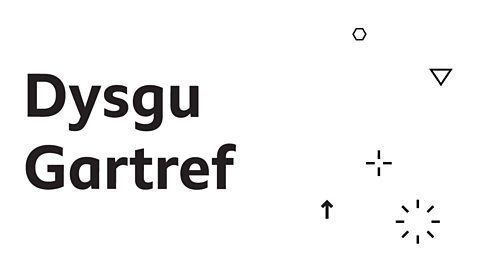
Ffocws dysgu
Dysga sut i sillafu geiriau lluosog afreolaidd yn gywir, ee car ÔÇô ceir, plentyn ÔÇô plant.
Mae'r wers hon yn cynnwys:
- pedwar gweithgaredd
Learning focus
Learn how to spell irregular plural words correctly, eg car ÔÇô ceir, plentyn ÔÇô plant.
This lesson includes:
- four activities
For an English version of this lesson, scroll below.

Beth yw enw?
Enw yw gair syÔÇÖn disgrifio peth arbennig, er enghraifft:
- lleoliad (ÔÇśystafellÔÇÖ; 'adeilad'; 'cartref')
- person (ÔÇśdisgyblÔÇÖ; 'nith'; 'pennaeth')
- gwrthrych (ÔÇścyfrifiadurÔÇÖ; 'bwrdd'; 'afal')
Enw priod
Mae enw priod yn disgrifio:
- enw penodol person (Megan; Ryan)
- enw lleoliad daearyddol (Bangor; Caerffili)
- enw mis (mis Chwefror) neu
- enw gwlad, talaith neu ardal (Cymru; Rwsia; Awstralia; Patagonia)
Rhaid i bob enw priod ddechrau gyda phrif lythyren.
Enwau lluosog
Yn ogystal ag enwau unigol ac enwau priod, mae hefyd gennym ni enwau lluosog.
Ystyr 'lluosog' yw mwy nag un, ee:
enw unigol yw merch, gan mai at un ferch maeÔÇÖn cyfeirio
enw lluosog yw merched gan ei fod yn cyfeirio at fwy nag un ferch
enw unigol yw bachgen, gan mai at un bachgen maeÔÇÖn cyfeirio
enw lluosog yw bechgyn , sef mwy nag un bachgen
Rydyn niÔÇÖn defnyddio'r gair hyn ar ├┤l enwau lluosog, ee:
- y merched hyn
- y bechgyn hyn
Does dim ffurf luosog ar enwau priod.
Ffurfio'r lluosog
Sut mae ffurfio'r lluosog?
Mae nifer fawr o ffurfiau lluosog ar enwau yn Gymraeg.
Dyma rai ffyrdd i greuÔÇÖr ffurf luosog:
- ychwanegu terfyniad, ee:
- crys > crys__au__
- marc > marc__iau__
- gwers > gwers__i__
- ystafell > ystafell__oedd__
- disgybl > disgybl__ion__
- cath > cath__od__
- newid llafariad, ee:
- t┼Ě > t__ai__
- car > c__ei__r
- ychwanegu terfyniad a newid llafariad, ee:
- bawd > b__o__d__iau__
- pwt > p__y__t__iau__
- cadair > cad__eiriau__
- athro > athr__awon__
- gair > g__eiriau__
- cael gwared oÔÇÖr terfyniad unigol, ee:
- moch__yn__ > moch
- cael gwared oÔÇÖr terfyniad unigol a newid y llafariad, ee:
- pl__e__nt__yn__ > plant
- newid terfyniad unigol gyda therfyniad lluosog, ee:
- nodyn > nod__au__
- newid terfyniad unigol gyda therfyniad lluosog a newid y llafariad, ee:
- bachgen > b__e__chg__yn__
- weithiau bydd geiriau benthyg yn defnyddio ffurfiau lluosog syÔÇÖn debyg i Saesneg ar ddiwedd gair, ee:
- banana > banana__s__
- bocs > bocs__ys__
Defnyddio geiriadur
MaeÔÇÖr geiriadur yn gallu rhoi gwybodaeth i ni am ffurf luosog enw.
Fel hyn maeÔÇÖn gallu ymddangos yn y geiriadur:
- car, eg (ceir)
- coeden, eb (coed)
Mae hyn yn dangos mai ffurf luosog yr enw gwrywaidd car yw ceir, a ffurf luosog yr enw benywaidd coeden yw coed.
Neu weithiau bydd yn ymddangos fel hyn:
- cyfrifiadur, eg. ll. -on
- cot, eb. ll. -iau
Mae hyn yn dangos mai ffurf luosog yr enw gwrywaidd cyfrifiadur yw cyfrifiaduron a ffurf luosog yr enw benywaidd cot yw cotiau.
Weithiau, maeÔÇÖn anodd gwybod beth yw lluosog gair yn Gymraeg, felly os wyt tiÔÇÖn dod ar draws ffurf newydd, noda fe lawr a dysga fe.

Gweithgaredd 1
DefnyddiaÔÇÖr geiriadur i ddarganfod ffurf luosog yr enwau unigol canlynol.
| Enw unigol | Enw lluosog | |
|---|---|---|
| gwlad | ||
| ysgol | ||
| llyfr | ||
| bwrdd | ||
| plentyn | ||
| bachgen | ||
| nofel | ||
| car | ||
| baban | ||
| cath | ||
| athro | ||
| cwningen | ||
| adeilad | ||
| papur | ||
| rhiant | ||
| cadair | ||
| brawd | ||
| anifail | ||
| bag | ||
| teulu | ||
| enw | ||
| pentwr | ||
| chwaer | ||
| peth |

Gweithgaredd 2
Gwna restr o dy hoff bethau yn y t┼Ě, ee poster; ff├┤n; cyfrifiadur. Wedyn ysgrifennaÔÇÖr ffurf luosog nesaf at bob gwrthrych.
Gwiria dy atebion drwy edrych mewn geiriadur ar-lein, ee Y Termiadur Addysg.
Pa mor gywir oeddet ti?

Gweithgaredd 3
Clica ar y llun i agor y gweithgaredd. Uwcholeua'r holl enwau rwyt ti'n gallu eu gweld yn y testun.
Enwau unigol ydyn nhw i gyd heblaw un - wyt ti'n gallu cael hyd i'r unig enw lluosog yn y darn?

Gweithgaredd 4
Darllena'r adolygiad ffilm ganlynol, ac uwcholeua'r enwau unigol, lluosog ac enwau priod yn y testun.

What is a noun (enw)?
A noun is a word depicting something specific, for example:
- location (ÔÇśystafellÔÇÖ; 'adeilad'; 'cartref') (ÔÇśroomÔÇÖ; ÔÇśbuildingÔÇÖ; ÔÇśhomeÔÇÖ)
- person (ÔÇśdisgyblÔÇÖ; 'nith'; 'pennaeth') (ÔÇśpupilÔÇÖ; ÔÇśnieceÔÇÖ; ÔÇśheadteacherÔÇÖ)
- object (ÔÇścyfrifiadurÔÇÖ; 'bwrdd'; 'afal') (ÔÇścomputerÔÇÖ; ÔÇśtableÔÇÖ; ÔÇśappleÔÇÖ)
Proper nouns
A proper noun (enw priod) depicts:
- a specific personÔÇÖs name (Megan; Ryan)
- the name of a geographical location (Bangor; Caerffili) (Bangor; Caerphilly)
- the name of a month (mis Chwefror) (February) or
- the name of a country, state or area (Cymru; Rwsia; Awstralia; Patagonia) (Wales; Russia; Australia; Patagonia)
Every proper noun must begin with a capital letter.
Plural nouns
As well as singular nouns and proper nouns, we also have plural nouns.
ÔÇśPluralÔÇÖ means more than one, eg:
merch (girl) is a singular noun, because it refers to one girl
merched (girls) is a plural noun because it refers to more than one girl
bachgen (boy) is a singular noun, because it refers to one boy
bechgyn (boys) is a plural noun, which means more than one boy
We use the word hyn (these) after plural nouns, eg:
- y merched hyn (these girls)
- y bechgyn hyn (these boys)
Proper nouns have no plural form.
Forming plural nouns
How do we form plural nouns?
There are many plural forms for nouns in Welsh.
Here are some ways of forming plural nouns in Welsh:
- adding an ending, eg:
- crys > crys__au__ (shirt > shirts)
- marc > marc__iau__ (mark > marks)
- gwers > gwers__i__ (lesson > lessons)
- ystafell > ystafell__oedd__ (room > rooms)
- disgybl > disgybl__ion__ (pupil > pupils)
- cath > cath__od__ (cat > cats)
- changing a vowel, eg:
- t┼Ě > t__ai__ (house > houses)
- car > c__ei__r (car > cars)
- adding an ending and changing vowels, eg:
- bawd > b__o__d__iau__ (thumb > thumbs)
- pwt > p__y__t__iau__ (bit > bits)
- cadair > cad__eiriau__ (chair > chairs)
- athro > athr__awon__ (teacher > teachers)
- gair > g__eiriau__ (word > words)
- removing the singular ending, eg:
- moch__yn__ > moch (pig > pigs)
- removing the singular ending and changing the vowels, eg:
- pl__e__nt__yn__ > plant (child > children)
- replace the singular ending with a plural ending, eg:
- nodyn > nod__au__ (note > notes)
- replace the singular ending with a plural ending and change the vowels, eg:
- bachgen > b__e__chg__yn__ (boy > boys)
- sometimes words borrowed from other languages will use plural forms similar to the English forms at the end of words, eg:
- banana > banana__s__ (banana > bananas)
- bocs > bocs__ys__ (box > boxes)
Using a dictionary
A dictionary can give us information about the plural form of a noun.
It may look like this in a dictionary:
- car, eg (ceir) (car, masculine noun (cars))
- coeden, eb (coed) (tree, feminine noun (trees))
This shows that the plural form of the masculine noun car is ceir, and that the plural form of the feminine noun coeden is coed.
Or sometimes it will look like this:
- cyfrifiadur, eg. ll. -on (computer, masculine noun, plural -s)
- │Ž├┤│┘, eb. ll. -iau (coat, feminine noun, plural -s)
This shows that the plural form of the masculine noun cyfrifiadur is cyfrifiaduron, and that the plural form of the feminine noun cot is cotiau.
Sometimes itÔÇÖs difficult to know what the plural form of a word is in Welsh, so if you come across a new form, jot it down and learn it.

Activity 1
Use the dictionary to discover the plural forms of the nouns below.
| Enw unigol / Singular noun | Enw lluosog / Plural noun | |
|---|---|---|
| gwlad (country) | ||
| ysgol (school) | ||
| llyfr (book) | ||
| bwrdd (table) | ||
| plentyn (child) | ||
| bachgen (boy) | ||
| nofel (novel) | ||
| car (car) | ||
| baban (baby) | ||
| cath (cat) | ||
| athro (teacher) | ||
| cwningen (rabbit) | ||
| adeilad (building) | ||
| papur (paper) | ||
| rhiant (parent) | ||
| cadair (chair) | ||
| brawd (brother) | ||
| anifail (animal) | ||
| bag (bag) | ||
| teulu (family) | ||
| enw (name) | ||
| pentwr (pile) | ||
| chwaer (sister) | ||
| peth (thing) |

Activity 2
Make a list of your favourite things in the house, eg a poster; your mobile phone; the computer. Then write the plural form next to each object.
Check your answers by looking in an online dictionary, eg Y Termiadur Addysg.
How correct were you?

Activity 3
Click on the image below to open the activity. Highlight all the nouns you can see in the text.
The nouns are all singular apart from one - can you find the only plural noun in the piece?

Activity 4
Read the following film review, and highlight the singular, plural and proper nouns in the text.

Hafan 91╚╚▒Č Bitesize
Gwyddoniaeth, Saesneg, Hanes a mwy - mae popeth yma i ti

Cynnwys y tymor hwn
Fideos, cwisiau a gweithgareddau i dy gefnogi yn ystod y tymor hwn

TGAU
Canllawiau dysgu i'r rhai ym mlwyddyn 10 ac 11
